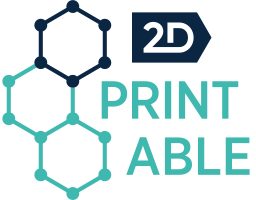In the 2D-PRINTABLE project, recent advancements in the defect and covalent functionalization of two-dimensional (2D) materials have been achieved, using transition metal dichalcogenides (TMDs) as the model substance.
While many different functionalisation strategies for TMDs are described in the literature to date, the mechanistic understanding is very premature due to a range of complex interactions that can occur between the functional group and the TMD itself, as well as the different types of defects that might be present. To exploit chemical functionalisation for next-generation printed electronics, e.g. to achieve controllable and stable chemical doping, nanosheet cross-linking in networks, or further tune nanosheet properties, it is crucial to fundamentally understand the underlying interactions.
In the first few months of the project, the two most widely used functionalisation strategies were studied: i) Filling of chalcogen vacancy defects with thiols and ii) Electrophilic radical addition using diazonium salts. For the thiol-based functionalisation, we could further extend the versatility of the approach by applying the concept also to telluride-based TMDs and by using disulfides instead of thiols.
For the diazonium functionalisation, the main aim was to gain a deeper understanding of the chemical binding and the role of defects by using the same reaction sequence in comparative studies using MoS2 produced by different exfoliation methods. For the first time, diffuse reflectance infrared Fourier transform (DRIFT) spectroscopy allowed the identification of characteristic vibrations from the grafting to the MoS2 surface providing evidence that both a covalent S-C bond is formed, as well as anchoring to oxygen-containing defects (e.g. sulfonyl and sulfoxides).
In conclusion, we demonstrated the versatility of thiol chemistry for selenide and telluride-based TMDs, deepened our understanding of diazonium-based functionalisation for nanosheets from various exfoliation methods, and established DRIFT as a new tool for semi-quantitative assessment and analysis of organic molecules on nanosheet surfaces.
For more information, the full report is available here.


